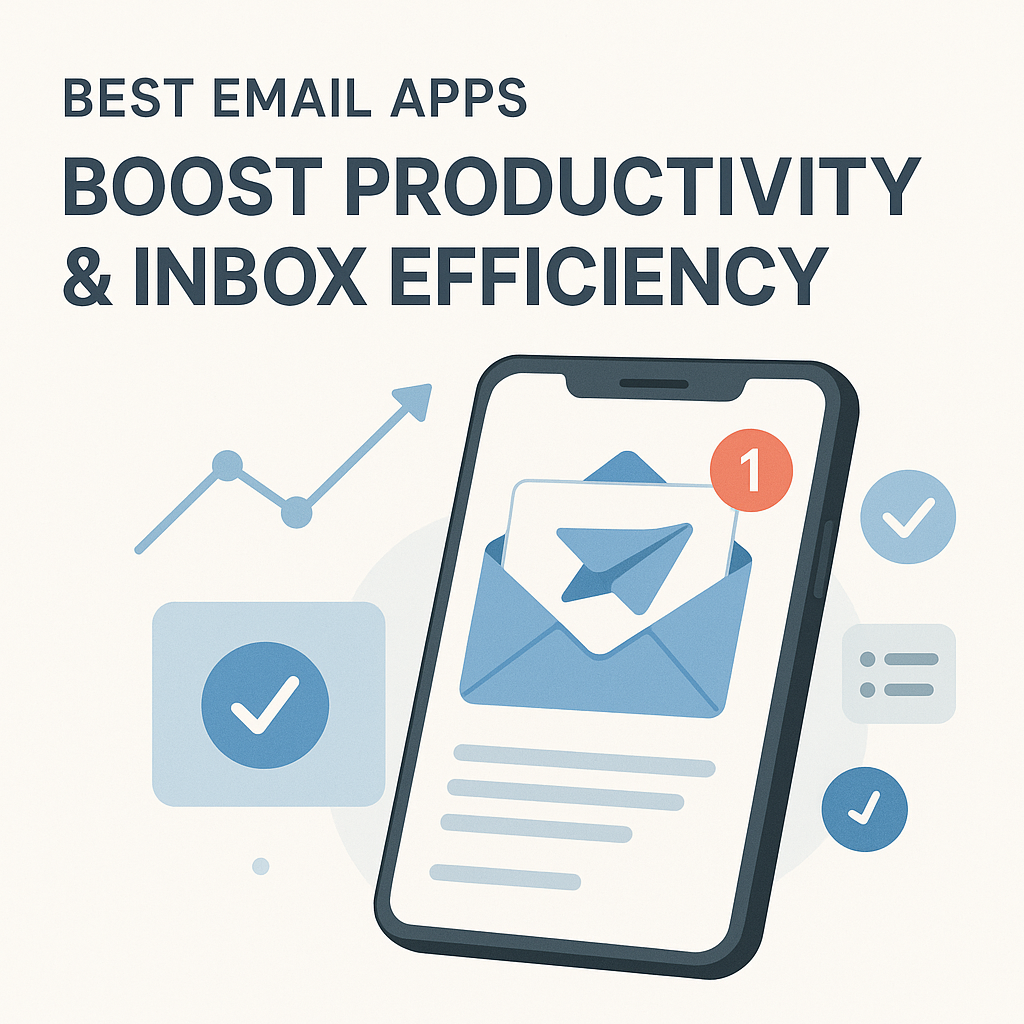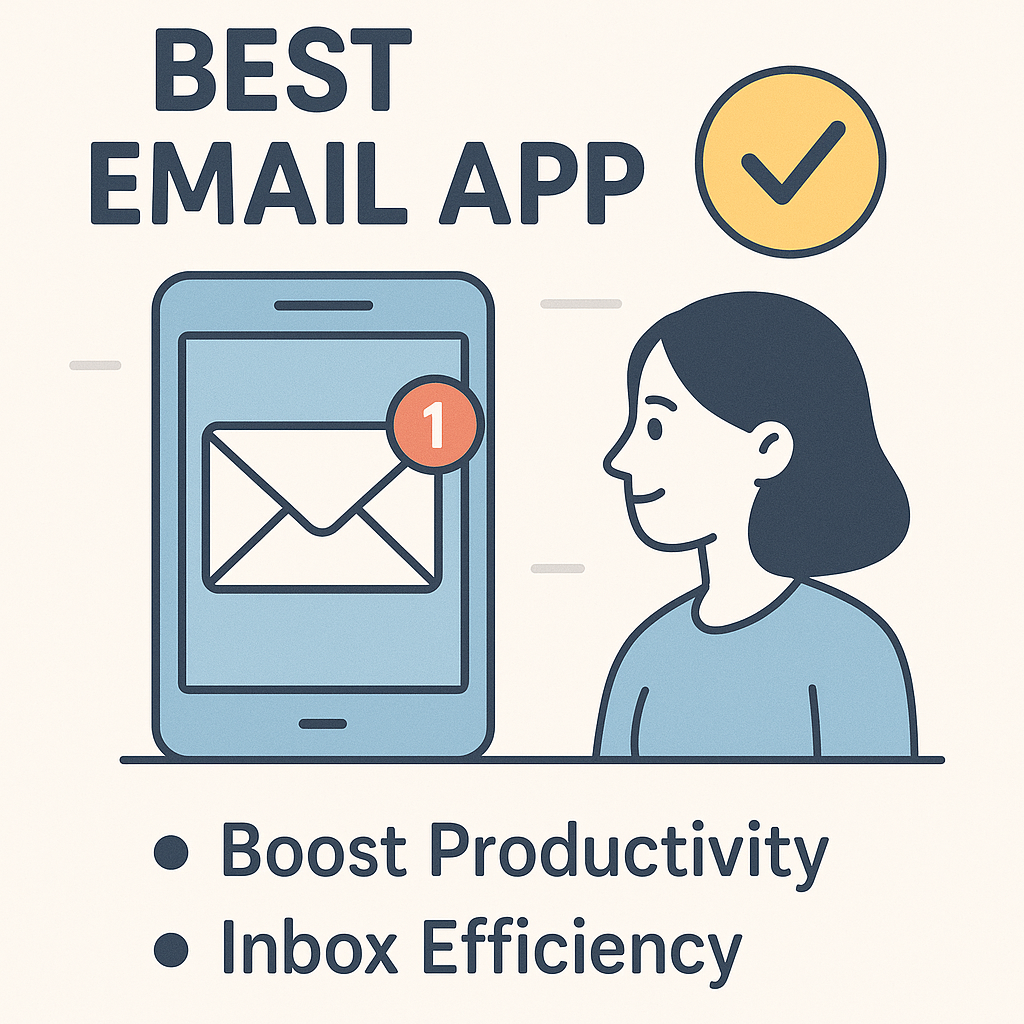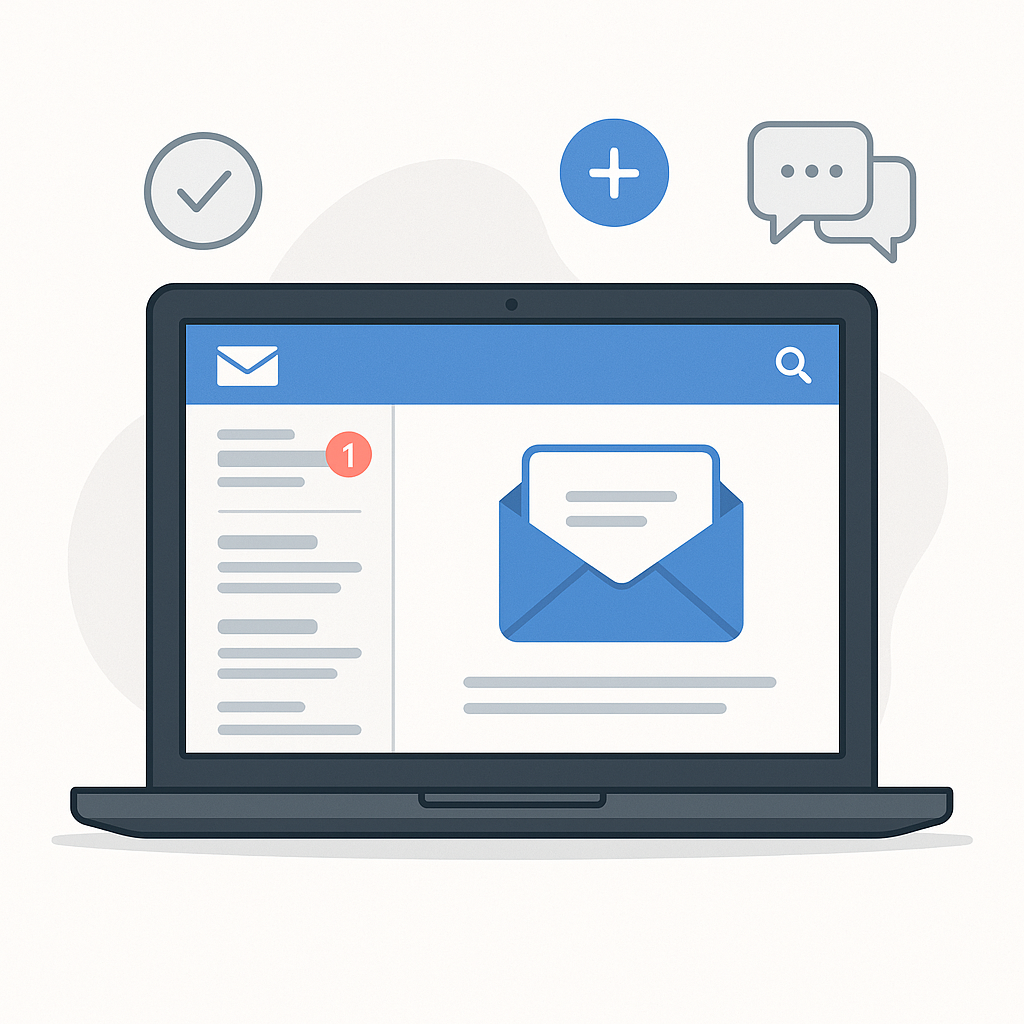Best Email Apps: Boost Productivity & Inbox Efficiency

In today's hyper-connected world, your inbox can feel less like a communication tool and more like a digital battlefield. The constant barrage of emails, notifications, and follow-ups can quickly lead to inbox overload, draining your energy and hindering your productivity. For busy professionals, managing this influx efficiently isn't just a convenience; it's a necessity for success. This is where the right email app can make a world of difference. Moving beyond basic email clients, modern applications offer sophisticated features designed to streamline workflows, automate tasks, and bring order to the chaos. But with so many options available, how do you find the best email app to truly boost your productivity and conquer your inbox?
This comprehensive guide will explore the top contenders, dissecting their features, user interfaces, and integration capabilities. We'll delve into how these tools cater to diverse needs, from handling high-volume inboxes and facilitating team collaboration to ensuring seamless mobile access. Crucially, we'll highlight the transformative power of AI-driven features and how they, along with specialized platforms, can revolutionize your efficient email management. By the end of this article, you'll have a clear roadmap to selecting and leveraging the perfect email app for your professional life, ensuring your inbox becomes a powerful asset, not a persistent burden.
Understanding Your Needs: Choosing the Right Email App
Before diving into specific app recommendations, it's crucial to understand that the "best" email app is highly personal. What works wonders for one professional might be overkill or insufficient for another. Identifying your specific requirements is the first step toward finding your ideal inbox solution. Consider these key factors:
- Email Volume and Complexity: Do you receive hundreds of emails daily? Are they primarily internal communications, client inquiries, or a mix? High-volume users might benefit from apps with advanced filtering, prioritization, and bulk action capabilities.
- Collaboration Needs: If you work in a team, do you need shared inboxes, team assignment features, or internal notes on emails? Solutions designed for team collaboration can transform how your group handles customer support or shared projects.
- Mobility Requirements: How often do you access your email on the go? A robust mobile app with offline capabilities, quick actions, and an intuitive interface is essential for professionals who are frequently away from their desks.
- Integration with Other Tools: Does your email app need to sync with your CRM, calendar, project management software, or cloud storage? Seamless integration can prevent context switching and keep your entire workflow connected.
- Security and Privacy: For many businesses, data security is paramount. Look for apps that offer strong encryption, robust spam and phishing protection, and clear privacy policies.
- User Interface (UI) and User Experience (UX): A clean, intuitive, and customizable interface can significantly impact your daily productivity. Some users prefer minimalist designs, while others appreciate feature-rich dashboards.
By honestly assessing these needs, you can narrow down your options and focus on apps that align with your professional workflow and priorities.
Top Email Apps for Business Professionals: A Comparative Review
The market offers a wide array of email applications, each with its strengths. Here's a look at some of the leading contenders that cater specifically to the needs of business professionals, helping you manage email inbox effectively.
1. Gmail (and its Ecosystem)
For many, Gmail is the default email service, and for good reason. Its web interface is powerful, offering excellent search capabilities, robust filtering, and integration with the vast Google Workspace ecosystem. When looking for enhanced functionality, exploring the best email client for Gmail is a smart move.
- Strengths: Ubiquitous, excellent search, strong spam filtering, deep integration with Google Drive, Calendar, Meet, etc.
- Ideal for: Individuals and businesses already invested in Google Workspace, users who value powerful search and organization.
- Productivity Boost: Features like smart replies, email snoozing, and labels are built-in. For advanced users, third-party clients can add even more power. Exploring how to boost productivity with Gmail is a common goal for many professionals. Check out our guide on Business Email Gmail: Boost Your Productivity for more insights.
2. Microsoft Outlook
Outlook remains a powerhouse, especially for those within the Microsoft ecosystem. Its desktop client is feature-rich, offering advanced calendar management, task integration, and robust rules. The web version is also highly capable.
- Strengths: Excellent calendar and task integration, powerful rules and sorting, robust enterprise features, widely used in corporate environments.
- Ideal for: Microsoft Office 365 users, corporate environments, professionals who rely heavily on integrated calendar and task management.
- Productivity Boost: Outlook's strength lies in its integrated suite. You can easily schedule meetings, assign tasks, and manage multiple accounts from one place.
3. Spark Mail
Spark has gained popularity for its intelligent features and clean interface. It aims to declutter your inbox by categorizing emails and offering smart notifications.
- Strengths: Smart Inbox (prioritizes important emails), snooze, send later, recurring emails, shared inboxes, real-time collaboration on emails.
- Ideal for: Individuals and teams looking for a smarter, more organized way to manage their inbox, with strong collaboration features.
- Productivity Boost: Spark's Smart Inbox automatically sorts emails into categories like "Personal," "Notifications," and "Newsletters," allowing you to focus on what matters most. As noted by Toolfinder, Spark Mail is considered "Best for All Round" for its comprehensive feature set.
4. Edison Mail
Edison Mail offers a streamlined experience with a focus on privacy and essential productivity features. It's known for its speed and clutter-reducing capabilities.
- Strengths: Clean interface, email tracking blocker, unsubscribe assistant, bundled receipts, read receipts, customizable swipes.
- Ideal for: Users seeking a simple, fast, and privacy-focused email client, particularly on mobile.
- Productivity Boost: Features like the unsubscribe assistant and receipt bundling help quickly clear out clutter and manage transactional emails.
5. Superhuman
Superhuman is designed for speed and efficiency, targeting power users who want to achieve "inbox zero" rapidly. It's known for its keyboard-centric interface and focus on speed.
- Strengths: Blazing fast, keyboard shortcuts, smart search, read status tracking, undo send, instant replies.
- Ideal for: Professionals who prioritize speed and efficiency above all else and are willing to pay a premium for a highly optimized experience.
- Productivity Boost: Superhuman's design philosophy is centered on minimizing friction, allowing users to process emails at an unprecedented pace.
Other notable mentions for team collaboration include Hiver and Front, which transform your inbox into a central hub for customer service and team communication, as detailed in resources like G2's list of best email management software.
AI-Powered Features in Email Apps: Revolutionizing Inbox Management
The integration of Artificial Intelligence (AI) is perhaps the most significant advancement in modern email applications. AI is transforming how we interact with our inboxes, automating mundane tasks, prioritizing crucial information, and even helping us communicate more effectively. These AI email features are no longer futuristic concepts; they are practical tools available today.
- Smart Replies and Drafting: AI can analyze the content of an incoming email and suggest short, relevant replies, saving you typing time. More advanced AI can even help draft entire emails based on brief prompts or previous conversations.
- Intelligent Prioritization: AI algorithms can learn which emails are most important to you based on sender, keywords, and your past interactions. This helps surface critical messages, ensuring you don't miss important communications amidst the noise. This is akin to having an AI email filter that truly understands your workflow.
- Automated Categorization and Filing: Many apps use AI to automatically categorize emails into folders like "Receipts," "Travel," "Social," or "Promotions." This significantly reduces the manual effort required for email organization tips.
- Scheduling and Snoozing: AI can suggest optimal times to send emails or remind you to follow up on messages, helping to keep your communication pipeline moving smoothly. This ties into broader concepts of AI email task automation.
- Natural Language Processing (NLP): AI uses NLP to understand the intent and context of emails. This can be used for extracting action items, identifying sentiment, or summarizing long threads. For instance, tools focused on email text extraction can pull key data points directly from messages.
- Spam and Phishing Detection: AI continuously learns from new threats to provide more sophisticated protection against malicious emails than traditional rule-based filters.
These AI capabilities are designed to reduce cognitive load and free up your time. For professionals looking to delegate and automate, leveraging tools like an ai executive assistant can further enhance email management by handling complex scheduling, drafting responses, and ensuring timely follow-ups, acting as a powerful extension of your productivity.
Integrating with Productivity Platforms: Enhancing Your Workflow
The true power of an email app is amplified when it integrates seamlessly with your other productivity tools. This creates a cohesive ecosystem where information flows freely, reducing manual data entry and context switching.
CRM Integration: Connecting your email app to your Customer Relationship Management (CRM) system (like Salesforce, HubSpot, or Zoho CRM) allows you to log emails directly against customer records, track communication history, and gain a 360-degree view of your client interactions. This is crucial for sales and customer success teams.
Project Management Tools: Integrating with tools like Asana, Trello, or Monday.com enables you to convert emails into tasks, assign them to team members, and track progress directly from your inbox. This is a key aspect of workflow optimization.
Calendar and Scheduling Tools: While most email clients have built-in calendars, advanced integration with dedicated scheduling tools (like Calendly or Acuity Scheduling) can streamline the process of booking meetings. You can often share your availability or book meetings directly from an email.
Cloud Storage: Linking to services like Google Drive, Dropbox, or OneDrive makes it easy to attach large files or save email attachments directly to your cloud storage, ensuring organized access and version control.
AI Productivity Suites: As mentioned, specialized AI platforms can work in conjunction with your email client. They can take email data, process it, and trigger actions across other connected tools. For example, after extracting key information from a client's email, an AI tool could automatically create a new lead in your CRM or schedule a follow-up task. Exploring AI email task automation and smart email delegation can unlock significant efficiencies here.
By choosing an email app that plays well with your existing tech stack, you create a more powerful and interconnected productivity system. This approach is fundamental to achieving true efficient email management.
Mobile Email Management: Staying Productive on the Go
In today's mobile-first world, managing your email effectively from your smartphone or tablet is non-negotiable. Whether you're commuting, traveling, or simply away from your desk, your mobile email app needs to be as powerful and efficient as its desktop counterpart.
Best Practices for Mobile Email Management:
- Prioritize Notifications: Configure your mobile app to only notify you for emails from important contacts or containing specific keywords. This prevents constant interruptions.
- Utilize Quick Actions: Most mobile email apps offer swipe gestures or quick action buttons for common tasks like archiving, deleting, snoozing, or marking as read. Learn and customize these to speed up your processing.
- Batch Processing: Instead of responding to emails as they arrive, set aside specific times during the day to process your inbox in batches. This minimizes context switching and improves focus.
- Leverage Smart Features: Make full use of any AI-powered features like smart replies or intelligent categorization that your mobile app offers.
- Offline Access: Ensure your app allows for offline access to emails and the ability to compose responses that will be sent when you regain connectivity.
- Keep it Clean: Regularly archive or delete old emails to keep your mobile inbox manageable and speed up loading times.
Apps like Spark Mail and Edison Mail are often praised for their excellent mobile experiences, offering intuitive interfaces and robust feature sets that translate well to smaller screens. For those on Android, a review of the best email apps for Android can offer tailored recommendations.
Security and Privacy Considerations: Protecting Your Data
When selecting an email app, especially for business use, security and privacy should be top priorities. Your inbox often contains sensitive information, and choosing an app that adequately protects this data is paramount.
- Encryption: Look for apps that offer robust encryption. This can include transport layer security (TLS) for data in transit and, ideally, end-to-end encryption (E2EE) for data at rest, meaning only you and the intended recipient can read the message.
- Data Handling Policies: Understand how the app provider handles your data. Do they scan your emails for advertising? What are their data retention policies? Opt for providers with clear, user-friendly privacy policies that prioritize user data protection.
- Authentication: Ensure the app supports strong authentication methods, such as two-factor authentication (2FA) or multi-factor authentication (MFA). This adds a crucial layer of security against unauthorized access.
- Phishing and Malware Protection: While all major email services offer some level of protection, AI-enhanced filtering and real-time scanning can provide superior defense against increasingly sophisticated phishing attacks and malware.
- Third-Party Integrations: Be cautious when granting access to third-party apps or services. Ensure you trust the developer and understand the permissions you are granting.
Choosing an email app that aligns with your organization's security standards and your personal comfort level with data privacy is essential for peace of mind and compliance.
Conclusion: Selecting the Best Email App for Your Workflow and Boosting Overall Productivity
The quest for the best email app is ultimately a journey to reclaim your time and focus. By understanding your unique needs—whether it's handling a high volume of messages, collaborating effectively with a team, or staying productive on the go—you can identify the tools that will best serve your professional life. We've explored how powerful applications like Gmail, Outlook, Spark Mail, Edison Mail, and Superhuman offer distinct advantages, from robust integration and user-friendly interfaces to specialized features.
The integration of AI is rapidly changing the landscape, offering intelligent solutions for prioritization, automation, and communication. As you look to optimize your workflow, consider how these AI capabilities can drastically reduce the time spent on repetitive tasks. For those seeking the pinnacle of efficiency, integrating specialized tools can be transformative. Leveraging an ai executive assistant, for example, can automate complex scheduling, manage follow-ups, and ensure critical communications are handled promptly, freeing you to focus on high-value strategic work. This is a key step in achieving true efficient email management and unlocking peak productivity.
Don't be afraid to experiment. Most apps offer free trials or freemium versions, allowing you to test them out and see how they fit into your daily routine. By carefully considering your requirements, exploring the features of different email productivity tools, and embracing the power of AI, you can transform your inbox from a source of stress into a powerful engine for your professional success. Start today by evaluating your current workflow and choosing the email app that empowers you to manage email inbox with greater ease and efficiency.



